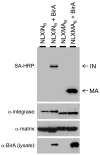In vivo biotinylation and capture of HIV-1 matrix and integrase proteins
- PMID: 19490971
- PMCID: PMC2691866
- DOI: 10.1016/j.jviromet.2009.03.017
In vivo biotinylation and capture of HIV-1 matrix and integrase proteins
Abstract
This report describes the adaptation of the biotin ligase BirA-biotin acceptor sequence (BAS) labeling system to biotinylate specific human immunodeficiency virus 1 (HIV-1) proteins in vivo. Two HIV-1 clones were constructed, with the BAS introduced into the matrix region of gag or the integrase region of pol. Specific biotinylation of target proteins in virions was observed when molecular clones were co-expressed with BirA. Both BAS-containing viruses propagated in SupT1 T-cells although replication of the integrase clone was delayed. Further studies demonstrated that the integrase insertion yielded an approximate 40% reduction in single-round infectivity as assessed on MAGI-5 indicator cells, as well as in the in vitro integration activity of preintegration complexes extracted from acutely infected C8166-45 T-cells. Biotinylation of the integrase BAS tag furthermore rendered this virus non-infectious. The matrix viral clone by contrast displayed wild-type behavior under all conditions tested. These results therefore establish a system whereby biotinylated matrix protein in the context of replication-competent virus could be used to label and capture viral protein complexes in vivo.
Figures








Similar articles
-
Replication of biotinylated human immunodeficiency viruses.J Virol Methods. 2011 Jan;171(1):299-302. doi: 10.1016/j.jviromet.2010.11.005. Epub 2010 Nov 16. J Virol Methods. 2011. PMID: 21087640 Free PMC article.
-
Analysis of HIV-1 Gag protein interactions via biotin ligase tagging.J Virol. 2015 Apr;89(7):3988-4001. doi: 10.1128/JVI.03584-14. Epub 2015 Jan 28. J Virol. 2015. PMID: 25631074 Free PMC article.
-
In vivo biotinylation of the major histocompatibility complex (MHC) class II/peptide complex by coexpression of BirA enzyme for the generation of MHC class II/tetramers.Hum Immunol. 2004 Jul;65(7):692-9. doi: 10.1016/j.humimm.2004.04.001. Hum Immunol. 2004. PMID: 15301857
-
In vivo biotinylation of bacterial magnetic particles by a truncated form of Escherichia coli biotin ligase and biotin acceptor peptide.Appl Environ Microbiol. 2010 Sep;76(17):5785-90. doi: 10.1128/AEM.00916-10. Epub 2010 Jul 9. Appl Environ Microbiol. 2010. PMID: 20622127 Free PMC article.
-
In vivo enzymatic protein biotinylation.Biomol Eng. 1999 Dec 31;16(1-4):119-25. doi: 10.1016/s1050-3862(99)00046-7. Biomol Eng. 1999. PMID: 10796994 Review.
Cited by
-
Changes in the accessibility of the HIV-1 Integrase C-terminus in the presence of cellular proteins.Retrovirology. 2010 Apr 5;7:27. doi: 10.1186/1742-4690-7-27. Retrovirology. 2010. PMID: 20367881 Free PMC article.
-
NF45 and NF90 Bind HIV-1 RNA and Modulate HIV Gene Expression.Viruses. 2016 Feb 16;8(2):47. doi: 10.3390/v8020047. Viruses. 2016. PMID: 26891316 Free PMC article.
-
Proteomic analysis of early HIV-1 nucleoprotein complexes.J Proteome Res. 2013 Feb 1;12(2):559-72. doi: 10.1021/pr300869h. Epub 2013 Jan 16. J Proteome Res. 2013. PMID: 23282062 Free PMC article.
-
Proteomics in the investigation of HIV-1 interactions with host proteins.Proteomics Clin Appl. 2015 Feb;9(1-2):221-34. doi: 10.1002/prca.201400101. Epub 2015 Jan 19. Proteomics Clin Appl. 2015. PMID: 25523935 Free PMC article. Review.
-
Knockdown of the cellular protein LRPPRC attenuates HIV-1 infection.PLoS One. 2012;7(7):e40537. doi: 10.1371/journal.pone.0040537. Epub 2012 Jul 12. PLoS One. 2012. PMID: 22808186 Free PMC article.
References
-
- Belshan M, Mahnke LA, Ratner L. Conserved amino acids of the human immunodeficiency virus type 2 Vpx nuclear localization signal are critical for nuclear targeting of the viral preintegration complex in non-dividing cells. Virology. 2006;346:118–126. - PubMed
Publication types
MeSH terms
Substances
Grants and funding
LinkOut - more resources
Full Text Sources

